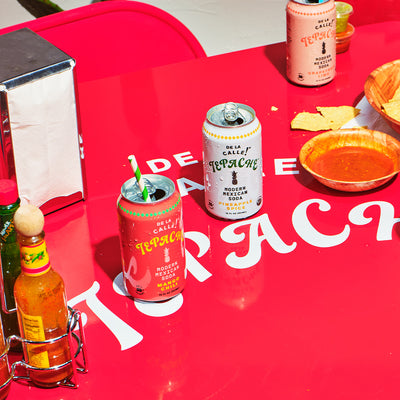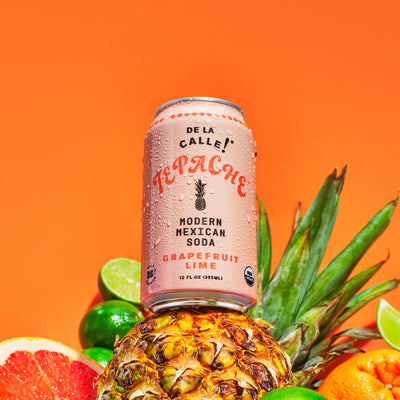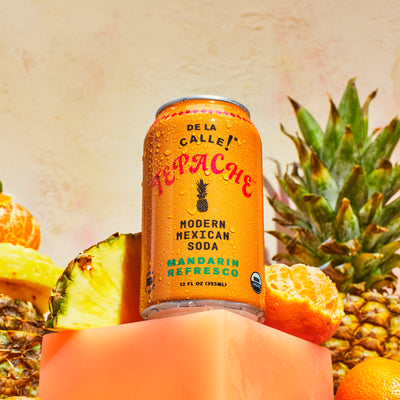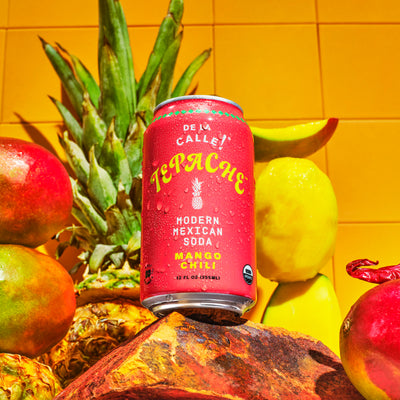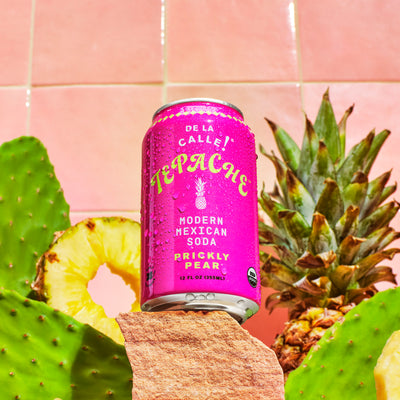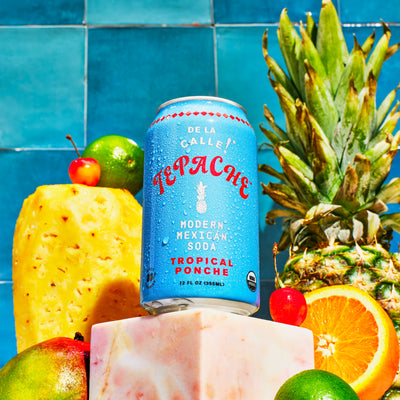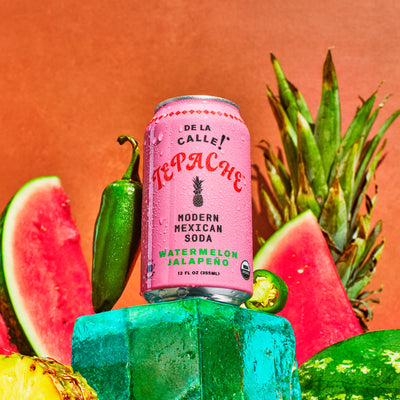What Is Chamoy And Why Do We Use It?

Chamoy is a delicious Mexican condiment/dip/sauce used to flavor grilled meats, give veggies a kick, flavor beverages, and top nachos. Although chamoy is a staple of Mexican cuisine, it was originally an Asian invention that was adopted and adapted by people in Mexico.
To learn more about this tasty topping, we’ll dive into the origins of chamoy, its ingredients, and what you can pair it with to spice up your diet.
The Origins of Chamoy
Chamoy began in China as a salty, dried apricot snack known as see mui. When said out loud, see mui sounds like “chamoy,” which is where the Mexican delicacy got its name. Chamoy might also come from the Japanese food umeboshi, a pickled tart plum or apricot. Once people from Asia began immigratIng to Mexico, chamoy was reinvented as a sauce and candy served with chilies.
Chamoy went through several transformations in Mexico to become what it is today. Originally, chamoy was a salted dried fruit made from a small, sour apricot. Chamoy is now sold as a sauce and a seasoning powder. Today, chamoy is also used to coat candies or made into a dipping powder for lollipops.
Chamoy’s Ingredients
Usually, chamoy is a condiment made from dried chilies, lime juice, and fruit. Although you can make chamoy at home, it is most often store-bought. Chamoy also comes in powdered and paste form, both of which are popular when it is used with candies and confections.
What Fruits Are in Chamoy?
There are a number of foods that can be used to make chamoy which include apricot, plum, and mango. To make chamoy, you first have to brine or salt cure the fruit. Once all the liquid is drained from the fruit, you can separate the solids from the liquid.
The leathery fruit is often eaten and sold separately as saladitos. This savory, sweet snack can be enjoyed on its own or with yogurt. The liquid that is leftover in the curing process is what becomes the base of the chamoy.
Spicy Chiles Give Chamoy Its Kick
Chili powder is added to the liquid from the curing process to give chamoy its kick. Given that chamoy contains chiles, it is often confused with Tajín, another popular condiment in Mexico. The main difference between chamoy and Tajín is that Tajín is a brand, whereas chamoy is a food.
Another difference between chamoy and Tajín is that chamoy is primarily enjoyed as a sauce, whereas Tajín is usually sold as a powder containing lime, salt, and chili powder. Although Tajín is usually used to top fruit, chamoy actually contains a fruit base, whereas the only fruit in Tajín is the dehydrated lime juice.
All that said, the brand Tajín does sell a chamoy sauce made from lime, salt, chilis, and apricot. However, when people talk about Tajín, they usually refer to the powdered spice. For this reason, when trying to differentiate chamoy from other condiments with lime and chili, remember that it is fruit-based, giving it a sweet, citrus flavor that makes chamoy distinct.
Lime Juice Adds Acidity to Chamoy
The final ingredient in chamoy is lime juice. The lime juice adds acidity to chamoy, which perfectly complements the sweetness of the fruit. The combination of fruit brine, chiles, and lime juice gives chamoy a taste similar to an Asian sweet and sour sauce. However, chamoy has a hotter and deeper flavor than these types of sauce.
The unique sweet-and-sour taste of chamoy allows it to pair well with light fruits, vegetables, cheeses, and dishes made with beans. Although chamoy is somewhat spicy, the sweetness of the fruit cuts through the spice, making it a nice topping for lighter foods. When you eat or prepare chamoy as candy, the sweetness comes through stronger than the salty and savory flavors in this condiment.
What Pairs Well With Chamoy?
One key to figuring out what to pair chamoy with is to remember that it is traditionally used on street food in Mexico. For this reason, we recommend pairing chamoy with grilled meats, veggies, tepache, and nachos, all of which are tasty treats sold on the street in Mexico. Check out this section for step-by-step instructions on how to incorporate chamoy into your favorite dishes and drinks.
Pair Grilled Meats With Chamoy
Although you can marinate and grill almost any meat with chamoy, pork loins are arguably the most popular choice for this tasty sauce. The best part about making chamoy pork loins is that it’s a quick and easy recipe for those hot summer nights when you want a tasty dinner fast.
To make apricot chamoy pork loins, you’ll need ancho peppers, apricots, lime juice, onion, and sugar. You’ll have to rehydrate the peppers first by placing them in a bowl of water for 30 minutes and then removing the stem and seeds. Once the peppers are rehydrated, place all ingredients in a food processor or blender and blend until smooth.
Once your marinade is ready, cover the meat in the sauce and let it sit in a refrigerator for 1-3 hours. Then toss the pork loins on the grill for a few minutes. Once the meat is cooked through, remove it from the grill and allow it to rest for ten minutes before serving.
Use Chamoy To Give Your Veggies a Kick
Another delicious way to use chamoy is to top your veggies with it. To do so, you first need to make or buy a chamoy sauce. Depending on the veggies you’re using, you might want a chamoy with an apricot, plum, or mango base.
Once your chamoy is ready, mix it with chili powder, lemon, and sugar. The addition of a little more heat, acid, and sugar will enhance the flavors and help the chamoy coat the veggies. From there, cut vegetables such as cucumber, carrots, and jicama into strips. Make sure you use vegetables that are tasty raw when making this recipe.
Place your sliced veggies into cups with a spoonful of the chamoy mix. If you want to add even more flavor, you can add a shake of Tajín to the top of the cup.
Sip on Spicy Chamoy Tepache
If you want to incorporate chamoy into your drink lineup, you can try our Chamoy tepache. This unique flavor of tepache is savory, umami, and tart all at once, with a little heat to keep you coming back for more.
Tepache is a traditional Mexican beverage made from fermented pineapple cores and rinds. The subtle citrusy flavor of the pineapple makes the flavor of tepache a little less funky than that of other fermented beverages like kombucha, which makes it the perfect base for stronger flavors such as chamoy.
You’ll want to sip our spicy Chamoy tepache on any hot summer’s day. Alongside being the perfect refreshing beverage, tepache also has several health benefits. As a natural source of both probiotics and prebiotics, tepache will give your gut a boost and help your immune system fight off harmful bacteria and viruses. Also, given that our tepache is naturally flavored, it does not contain all the added sugars of carbonated beverages such as soda.
Dip Chips and Nachos in Spicy Chamoy
Are you looking to take your nachos to the next level? If so, you might want to try making tostilocos, a snack made with tortilla chips and topped with cucumber, jicama, peanuts, tamarindo candy, chamoy hot sauce, lime juice, and more.
The first tostilocos were made in Tijuana in the 1990s by Javier Rodríguez. Since then, the recipe has evolved and grown into the phenomenon that it is today. To make tostilocos, you first need to spread a bag of tortilla chips out on a large serving platter or cut the top of a bag off to make your snack inside the bag.
After preparing your chips, top them with a layer of cucumber, jicama, mango, and any other of your favorite toppings. Sprinkle a layer of Japanese peanuts, tamarind candy, and curritos on top to add more of a crunchy kick. Finally, top your tostilocos with chamoy, hot sauce, lime juice, and Tajín. Enjoy!
Conclusion
Chamoy is a delicious Mexican condiment, sauce, and dip. Although chamoy has its origins in Mexico, it is an adaptation of snacks and condiments from either Chinese or Japanese cuisine. To make chamoy at home, you simply need a fruit base of either apricot, plum, or mango, and chilies and lime juice.
Once you have your chamoy, either store-bought or homemade, you are ready to incorporate it into all of your favorite dishes and drinks. You can use chamoy to grill meat, spice up veggies, flavor tepache, and make loaded nachos. Regardless of how you use chamoy, we know it will add a unique sweet and sour flavor to your cooking!
Sources:
A Systematic Review on the Health Effects of Plums (Prunus domestica and Prunus salicina) | NIH
Bioconversion of dietary provitamin A carotenoids to vitamin A in humans | NIG

